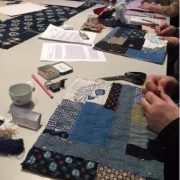Boro at Shizuka Ryokan
Sunday 9th February 2020
Shizuka Ryokan will celebrate Japanese textiles in February when Leanne O’Sullivan returns to teach a one-day boro workshop. Boro is a type of Japanese mending.
Spend a relaxed day with Leanne learning how to hand-stitch, mend & quilt layers of recycled cloth to give them new life in the traditional Japanese way.
Be inspired by Leanne’s personal collection of vintage Japanese boro textiles and discover how boro is being stitched by artisans in Tokyo today. All materials will be provided including vintage kimono cloth with Japanese threads, needles and thimble – everything you need to create your own textile treasures to wear or have in you home.
About the teacher
Leanne first visited Japan in the 1980s, where she lived and worked for 5 years. It was during this time that she became interested in Japanese textiles, and the kimono in particular.
“Whilst living in Japan I was constantly inspired by the extreme contrasts around me—everywhere I looked there seemed to be a mix of traditional and contemporary co-existing beautifully.”
This contrast is evident in Leanne’s pieces, which combine new and vintage fabric, and traditional and contemporary design. These days, Leanne runs Kimono House Japanese Textiles & Craft —where she trades Japanese textiles and craft kits, teaches workshops and exhibits her collection of Japanese textiles.
To learn more about boro you can read the blog post on Shizuka Ryokan’s Japanese culture blog.






